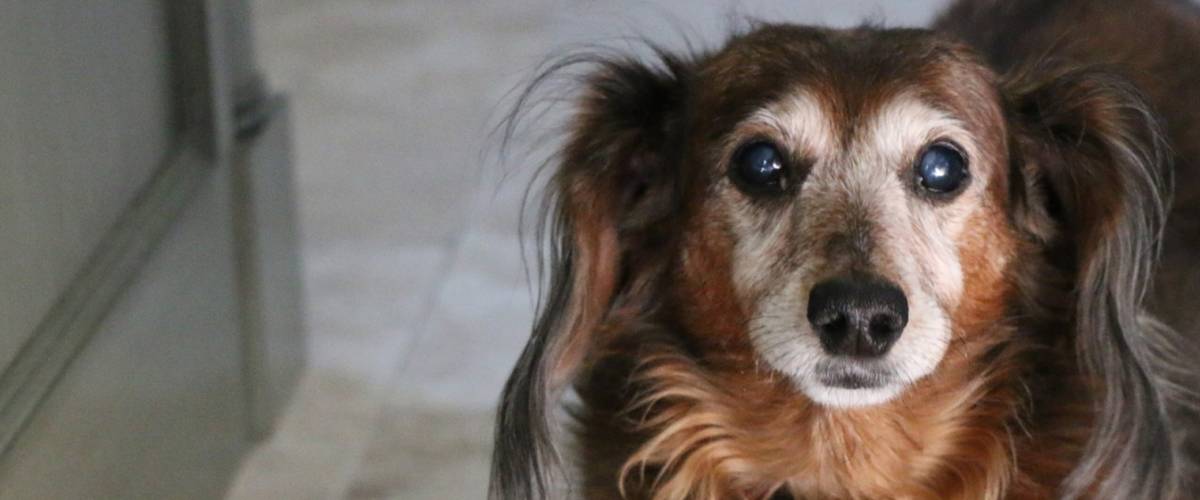
August 11, 2021 – Join Dr. Kelly Diehl as she talks to Dr. Margaret Gruen, Assistant Professor of Behavioral Medicine at North Carolina State University as they discuss cognitive dysfunction in dogs (and cats), including signs of decline, monitoring tools and quality of life for both pets and owners. They discuss diagnosis and treatment of this disease and what owners can do to help their elderly canine friends stay mentally fit!
Resources
CADES dementia scale: https://www.frontiersin.org/articles/10.3389/fvets.2020.551895/full
CCDR questionnaire: http://rng.org.au/wp-content/uploads/2014/09/CCDR-scale-revised.pdf
0:00:11.6 Dr. Kelly Diehl: Welcome to Fresh Scoop, episode 35, Understanding Canine Cognitive Dysfunction. I'm your host, Dr. Kelly Diehl, Morris Animal Foundation, Senior Director of Science and Communication. And today we'll be talking with Dr. Margaret Gruen. Dr. Gruen is an Assistant Professor of Behavioral Medicine at North Carolina State University College of Veterinary Medicine. So, Margaret, thanks for joining us today.
0:00:35.4 Dr. Margaret Gruen: Thanks for having me.
0:00:37.4 DD: So, before we get into your work, I always have all of our guests tell us a little bit about yourself and what led you sort of to veterinary medicine and behavior.
0:00:46.7 DG: Sure. I was always really fascinated by behavior even as a kid, just how animals interacted with us and with the world. And then while I was in vet school, I did a lot of work with shelters and came to realize how many of those pets were there for behavioral reasons, and that specializing in behavior might be a way to help try to keep pets in homes by preventing and treating behavior problems. And then really the more I became involved in behavior, the more excited I became about how we can use behavior as an outcome, really as a way to study conditions, like pain, anxiety and cognitive dysfunction, with the goal of developing treatments for those conditions.
0:01:25.0 DD: Yeah, I think you're right. They are such an important problem and I think neglected. I'm going to date myself by saying when I was in school in the '80s, we had a behavior person there, and it was the first time I ever encountered somebody, and they came from the neurology side, right? So, it was a neurologist that was starting to do some behavior, and it was amazing. Again, I would never have thought of it as a student, and of course it wasn't really part of our curriculum, it was only if you happened to be on clinic. So, this is really, really, I think, a huge and growing field. Let's move to what I wanted to talk with you about today, and I wanted to ask first, can you tell us what we know now about what happens as a dog's brain or dog brain begins to age?
0:02:14.7 DG: Yeah, we know a lot more now than we did before. So, brain aging happens to all of us, and it happens to our dogs, and as they age, they can have changes to their brain that include neuronal death, oxidative damage, the antioxidant activity decreases, so we see this increase in oxidative damage in large lateral ventricles, are a real hallmark sign, and general brain atrophy. Interestingly, they can also develop amyloid deposits and those do damage the brain tissue, and neuro inflammation can be present, and that's an area of really active research right now. And then we see a decrease in important neurotransmitters like acetylcholine, serotonin, norepinephrine, and dopamine, so some really big players.
0:03:01.7 DD: And I think you just mentioned amyloid, and I wanted to ask you a bit about... I think lots of folks listening, we all know something about dementia in people, and of course Alzheimer's disease, but can you tell us a little bit more about canine cognitive dysfunction? I remember a few years ago, maybe a couple of decades, 20 years ago, we weren't even... Nobody talked about this. Nobody was quite sure if it happened, and I remember a lot of discussion about when people first started to discuss it. So can you talk a little bit about it, and maybe we should start with the clinical signs you see first.
0:03:39.8 DG: Sure, and yeah, it really does have a lot of overlap with Alzheimer's disease, it's used as a naturally current model for Alzheimer's disease, so there's a lot that we can learn from the human side and the humans can learn from us, so it really is a fascinating overlap. But the clinical signs have been described using an acronym DISHA, D-I-S-H-A, and now there's an additional AL at the end. So, the D is for disorientation, and people will say that their dogs seem lost, they're not able to seem to recognize familiar places, going to the wrong side of doors is a really classic one, so just really seeming just a bit out of it.
0:04:21.2 DG: I is for changes in social interactions. And that can go one of two ways, they can either become more aloof, so less social interaction with the owners, or we see a switch to more attention-seeking behavior, so they really start seeking out their owners and needing to be around them.
0:04:37.7 DG: S is a big one, that's changes in the sleep-wake cycle, so generally, that's sleeping more during the day and then being awake at night. You can imagine that's one of the most troubling clinical signs for owners.
0:04:48.9 DG: H is house soiling. That one's only a sign if it's a new behavior. So, if it's a dog who was really well house-trained before and now is house soiling, that can be a sign.
0:05:00.5 DG: And then we've got A which is our changes in activity level. Generally, that's a decrease, but we also see really just a shift in the pattern, and that's reflected in that sleep-wake cycle changes, and we can see pacing at night, for example, so changes in activity.
0:05:15.6 DG: Then we've got our newest A and L. So, the first one, the A, was really a recognition that anxiety is a big component of cognitive dysfunction, we see that a lot in dogs with cognitive dysfunction. And then L is a decrease in ability to learn new tricks, so learning is impaired. So, it's really this constellation of behavioral signs that aren’t present at all times, so we work through that acronym to try to make the diagnosis.
0:05:45.1 DD: Okay, and I think just... I'll take a little sidestep here, is, I talked with some folks about feline, and I think the same acronym kind of goes for some feline behavior changes as well, right?
0:06:01.4 DG: It does, although in cats there's a push now... There's a paper coming out that talks about it being VISHDAAL, so instead of DISHA, partly because the DISHA sort of is a hierarchy of the signs that we see, and in cats the most prominent sign that we start to see is vocalization. So, vocalization at night in particular, but that is such a prominent sign in cats, that there's a shift to using VISHDAAL as the acronym for cats.
0:06:34.2 DD: Okay. So that's good for us to know. So DISHAAL is really more dogs and a hierarchy, and VISHDAAL for cats then.
0:06:43.3 DG: Yes. Yep.
0:06:43.4 DD: So, cool. So, I’ve got to think this is a tricky diagnosis, or is it not? Like, what tools do you use to make the diagnosis?
0:06:52.3 DG: It's a super tricky diagnosis, because it's one of exclusions, still. We have to rule out medical diseases... Or not really rule out, we have to understand what other medical diseases there are. These are senior pets, they may have other co-morbid conditions and those can contribute to behavior change, so we need to at least understand what they are and have managed them. And then we also need to rule out sensory changes, like a decline in vision or in hearing that could result in some of these behaviors. Ideally, we'd have an MRI, but this is very infrequently done. So, they really are... We're depending on asking owners about their behavioral signs. There’re questionnaires that have been developed and evaluated with psychometric tools. Currently, those are really the best options that we have. So, we'd love, and hope to in the future, have some clinically applicable cognitive tests or other biomarkers that we could use to diagnose it, especially early on in the course of the disease.
0:07:49.0 DD: Okay, so you mentioned MRI. Just really quickly, are there distinct signs or is it sometimes helpful but not always helpful for this diagnosis?
0:07:58.8 DG: So, we would look for distinct signs of brain atrophy, and also that increase of the size of the lateral ventricles is a really kind of hallmark sign. But it's also really to rule out other primary neurologic disease, so brain tumor could result in several of the same behavior. We actually... I had a case as a resident where I had a pituitary macroadenoma, and then also vascular infarcts, that would be another thing we'd want to rule out. So, the MRI really helps you also just rule out other medical conditions.
0:08:31.2 DD: Okay, so it's not because there are necessarily distinct signs other than what you mentioned, it's just part to try to rule this other stuff out. And that brings us to something I wanted to ask, which is what diseases mimic? You said that things can feed into canine cognitive dysfunction, but are there diseases that look a lot like it but are distinct?
0:08:53.0 DG: Yeah, so remembering not all dogs will have all of those signs, that each of those clinical signs has a huge, long list of possible differentials that need to be considered. Of course, as I mentioned, other neurologic disease we need to think about. And then one that I might be a little bit biased but I think is really important is chronic pain. So, dogs with chronic pain can look exactly like that, they can show a lot of these same signs, so that should also be checked for. And we know in people that it's a terrible cycle, chronic pain is associated with cognitive disturbances, particularly in executive function and attention, and then we can see then more pain. So, treating chronic pain is really an important part of the process.
0:09:36.7 DD: Okay. And I am assuming, just like in older people, some of these, you can have osteoarthritis and canine cognitive dysfunction too?
0:09:46.7 DG: Yes, yes. And so that's why it's really important to treat chronic pain along with whatever treatments we're putting in place for cognitive dysfunction.
0:09:56.5 DD: Right, and what are some of the treatments that are available for canine cognitive dysfunction?
0:10:04.7 DG: So here in the US, we have mostly a number of antioxidant treatments and supplements, so like SAMe and Omega-3 fatty acids are used a lot. There’re two diets actually specifically formulated for managing CCD; one is enriched with antioxidants and some vitamins and fatty acids, and the other uses antioxidants as well as medium chain triglyceride oil supplementation as an energy source. There is also an approved medication in the US for managing CCD, and that's Anipryl, or selegiline. So, this medication is an MOAI inhibitor, and it's given in the morning to kind of wake them up and try to reset that sleep-wake cycle. Sometimes we also have to use other treatments for managing symptoms, so that can include anxiolytics or SSRIs, especially when we have anxiety as one of the signs that we're seeing. But remembering, of course, that SSRIs can't be used with selegiline due to the high risk of serotonin syndrome when they're used together. So ,we have to balance all of these things when we're putting together our treatment plan.
0:11:08.4 DD: Right, and do you know, and I can't answer this, how many clinical, good clinical trials do we have out there that are evidence-based for some of these therapies? because I know some of them have been around for a while with the sort of like "Well, maybe it can't hurt" sort of attitude, but are people actually looking at this more critically?
0:11:29.5 DG: Yeah, so Anipryl for FDA approval went through clinical trials, and then some of the supplements have been evaluated. So CanCog is a group in Canada that does a lot of work, they manage a colony of older dogs, and younger dogs, but they've been able to really look at... They did some of the pioneering work really looking at where the deficits were and when they started to develop. They're kind of the reason that we know that some of the deficits that we see start around age six. We don't diagnose dogs with cognitive dysfunction till much later, so we're missing something really big in the middle. But they have done some work looking at improvements in performance on some of those tests, following supplementation with the diet or with one of the SAMe supplements, for example. So, there is some work out there looking at that.
0:12:23.9 DD: Okay. Yeah, that's pretty interesting, because I think it would be probably hard to do. This seems like it would be hard to do good clinical trials with, because it's a little squishy, right, versus like, "I got a broken leg and we're going to X-ray it and see how it heals. Right?
0:12:40.3 DG: Yeah.
0:12:41.4 DD: That seems to be something. So, getting back to that idea that this stuff may start much earlier than we expect; is there anything out there that people are looking at to slow progression? Which is sort of a holy grail in people too, with dementia, and Alzheimer's, because I know sometimes by the time you get to that point it's pretty darn hard to improve. But what are people looking at or what do you recommend?
0:13:09.0 DG: Yeah, so most of our treatments really focus on slowing that progression of disease and preserving the quality of life for the dog and the owner. And, as you said, we know some of the same things from humans that will work. So, staying active, staying socially engaged and staying mentally stimulated are the most important things. And we can apply those same ideas for dogs. So, we encourage people to provide really predictable routines for dogs, especially as anxiety starts to increase, getting good exercise, having those positive social interactions, and then mental enrichment, which can be all sorts of things. So, food puzzles obviously are one great one, but even scent walks, so taking dogs out and giving them opportunities to sniff around, doing nose work, play, positive reinforcement training. We really can focus on building those opportunities for mental enrichment. And then we also focus on trying to decrease anxiety, not only with the routines, but with making sure that we provide access to preferred areas for resting, for example. Making sure that they can still get to places. We'll sometimes see dogs who will stand on the edge of a room panting because they really want to come in and join their owner, but they have to get across this expanse of hardwood floor, which is basically like ice.
0:14:27.5 DG: So, it's really scary, and we see the anxiety go up there. So, providing even simple things like carpet runners if the floors are slippery can be helpful.
0:14:36.5 DD: Okay. And we can teach old dogs new tricks, right?
0:14:39.7 DG: We can. Yes. And we should.
[laughter]
0:14:44.8 DD: That's pretty fun. Yeah, I have an older dog and we used food puzzles mostly just because she's really active, and even as an older dog she is totally into those.
0:14:54.0 DG: Yeah, they can be great.
0:14:56.6 DD: She really, really likes them a lot. And I like the idea, I think you brought up a good point, is the consistency and routine, which can be important. I think we take it for granted, or I did with my other old dog, that... She's old, she's adjust, right? Or something. And not realizing that that can actually become more of a problem as they age, versus, oh, they're more flexible or something when they get older. But also what... You talked about diagnosis, what should a general practitioner start to do, or how should they approach when they see older patients like during a maybe a yearly health exam, or they're coming in for blood tests because they're going to have a dentistry, and considering when they... Or maybe work into their routine as they look at these patients?
0:15:48.1 DG: Yeah, I think it's really about starting that conversation with the owner. So, building awareness with the owner and engaging them, because they're the ones who are going to see it at home. These are all things that are best observed at home, and so we really have to engage and partner with owners. And so they need to know what to be looking for. And so starting that conversation early. I think we should start screening for it at our annual visits with all senior pets, maybe starting around age eight, so that we have of a baseline and then can track it. So, I think what's really interesting is that all this is still kind of being researched. It seems that it's not relative age, like a Great Dane will be a senior much earlier than a Chihuahua. It's more absolute age, so time on the earth, that's associated with CCD. So, using one of the standardized questionnaires, there are several, but picking one and sticking with it so that you can track the same thing over time can be really helpful. So, if you start with a baseline and then can watch that score as it changes over years, you might be able to pick up some changes much earlier. because, as I said, we're making this diagnosis when dogs are 11, 12, 13, we're missing something that's developing earlier, and maybe we can prolong that slowing of progression if we can detect it earlier.
0:17:06.2 DD: Okay. And, Margaret, can you give some of those resources right now, because for the folks who are listening, we can put them in the program notes?
0:17:13.7 DG: Oh, sure. So, one questionnaire is the CADES scale, the canine dementia scale. So that actually was tested in a large population of dogs and was shown to be able to categorize dogs into mild, moderate and severe cognitive impairment, and then they did show that they could track progression over time. There are other ones as well. Dr. Landsberg has one. There are several in the veterinary textbooks. So really it's about picking one that covers all of the clinical signs and can be tracked over time. But the CADES, and then another one, the CCDR. As long as you pick one and continue to use it. I think the CADES is one that's being used a lot more frequently now, because it does cover all the domains and really has been shown to be able to be associated with progression, so that's important.
0:18:02.5 DD: Okay, so you mentioned maybe looking earlier than we typically would do. I would never have thought of looking at a six or seven-year-old dog for cognitive problems when I was in practice. I mean, we might have discussed it, right, when 10 or 11. But what else have you seen, or what is the misperception that you often see in your practice, both with veterinarians and owners about cognitive declines?
0:18:32.8 DG: Yeah, I think... I really think there's two big ones. So, the first is that it's inevitable and part of getting old, and that's something we're really working on is, what does normal aging look like, and then what does pathologic aging look like? And then the second big one is that there's nothing we can do once we have diagnosed it. So really, while we can't cure it, there is still a lot we can do to promote the dog's comfort and their good quality of life. And, again, slow that progression.
0:19:00.4 DD: And as a person tuned into this community, what are people... What are some of the big research questions you see people working on, maybe you're working on, or your colleagues, to get at this problem?
0:19:13.6 DG: Yeah, really they focus a lot on risk factors, so understanding more about risk factors. Early diagnosis, again, six or seven, that's when we see laboratory changes; we're probably not seeing clinical signs that early, but I think we're seeing them earlier than we're making the diagnosis. Correlation of our behavioral signs with real cognitive testing, so that's a wide-open field. And then biomarkers for disease, so being able to have some sort of biomarker that might help us understand, okay, this is outside of normal, we might be seeing some signs of neuronal damage, for example. So, treatments, for sure, are important and those are being researched, but we also just have a lot we still need to understand about the disease and the disease process, and especially in those earlier stages of the disease, the more mild cognitive impairment.
0:20:02.1 DD: Right, so what do you think is the take-home message? We have veterinarians, vet students, technicians, and several owners who... Dog owners who listen to this. What would you tell them? I think you alluded to one that I think is really important, which is that it's inevitable, and I think that's really important to realize, not necessarily, but what else would you tell people?
0:20:26.2 DG: I also think I would tell them that this is just a really exciting time. So, with a lot of research, a lot of new resources are being developed, that we want to start people monitoring early for signs of CCD, not waiting until the signs are severe. I think it's really important to talk to people about, if you get really excited and you want to put all of these things in place, that you're actually dealing with a patient who might not adapt as well or cope as well, so we want to put those things in place gradually. So even increasing exercise or switching to food puzzles, you want to do that gradually, you don't just go from, you eat out of a bowl to you eat out of a very complicated toy. So that can... That's important for us to think about. And then I think it's also really important for us to consider the quality of life of the owner, and make sure that we're checking in about quality of life for both the dog and the owner, as we're working with these patients.
0:21:20.4 DD: Yeah. And can you talk a little bit more about that? What do you see that causes stress in the owner when they're dealing with these kinds of changes in their dog?
0:21:32.0 DG: Well, it depends on the clinical signs that we're seeing. So, if we see a dog becoming more socially separated from owners, or even more socially attached, that change in social interaction is difficult for people. You can imagine that dogs who are awake all night, especially if they're pacing, can be really difficult for people to manage, house soiling can be frustrating but that's usually manageable. It really is because there's nothing... People feel like there's nothing wrong with them really, right, they don't have a real disease or something that is this what's perceived as this real medical problem. And so I think it can be difficult for people to kind of keep track of where the patient's quality of life really is, and where the owner's quality of life really is, and figuring out how to set really end points for quality of life. How to have those end-of-life discussions with owners. I think that's something that's really important for us to think about, too. because it really is hard on owners and they don't know when it's too much.
0:22:38.0 DD: Right. Yeah, and I think you've hit on a good point. Having been an internist for a long time, for example, the classic hypoadrenocorticism dog, they pace that night, they pant... Oh, scratching itchy dogs, right? When you're hearing that collar go at three in the morning. And I think you bring up a really good point, which is the owner's self-care and awareness. I think a lot of people feel guilty ever saying, This is really troubling me, or this is keeping me up at night, or this is really a hassle. And I think you've hit on some really good points on owners, taking the owner's feelings into consideration. Sometimes with hypoadrenocorticism, at least you can tell people, "Well, if we treat it, there's a chance the panting and some of the night stuff," but... Right. For some cases like a coughing dog. Those are really hard to... Those have a lot of impact, and I'm glad you brought that up, because I think getting owners to realize, Yeah, it is a hassle and you're allowed to feel frustrated about it, because it does impact your relationship with your dog. That's a really good point, I think I hadn't thought about.
0:23:48.8 DD: So, we'll get the resources that we mentioned up on the website, and I wanted to thank Margaret, because we're at the end of our time, so much for joining us. It went so fast.
0:24:01.3 DG: Yeah, this was fun. Thank you.
0:24:03.0 DD: And I'll look forward to hearing more from you and seeing what's coming. I know at the foundation, we're seeing actually more people interested in this topic that, when I started eight years ago, we would have had very few behavior-oriented grants being submitted to us, and we have a lot more. So that does it for this episode of Fresh Scoop and once again thanks to Dr. Margaret Gruen for joining us. And we'll be back with another episode next month that we hope you'll find just as informative, because we know the science of animal health is always changing. And veterinarians and owners and vet techs and vet students, all you guys out there that listen to us, you need the best and cutting-edge research information to give your patients the best care, and that's why we're here. You can find us on iTunes, Spotify, Google podcast and Stitcher. And of course, if you like today's episode, we'd sure appreciate if you'd take a moment to rate us, because that helps others find us in that giant sea of podcasts that is out there.
0:25:03.0 DD: And, of course, to learn more about Morris Animal Foundation's work, again, go to morrisanimalfoundation.org, and there you'll see just how we bridge science and resources to advance the health of animals. And you can also follow us on Facebook, Twitter and Instagram. And I'm Dr. Kelly Diehl and we'll talk soon.




